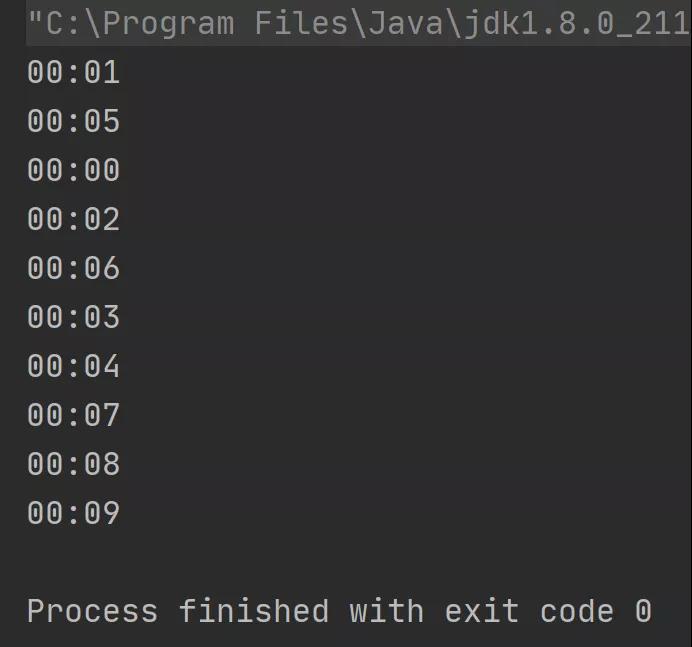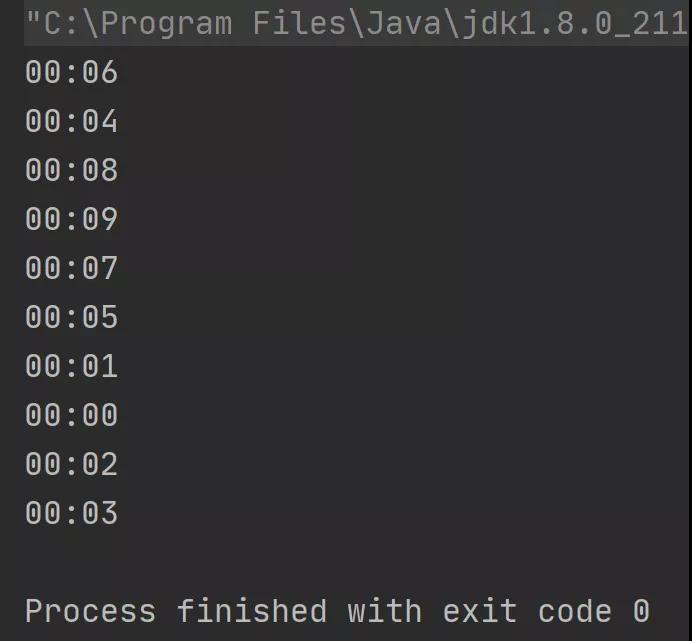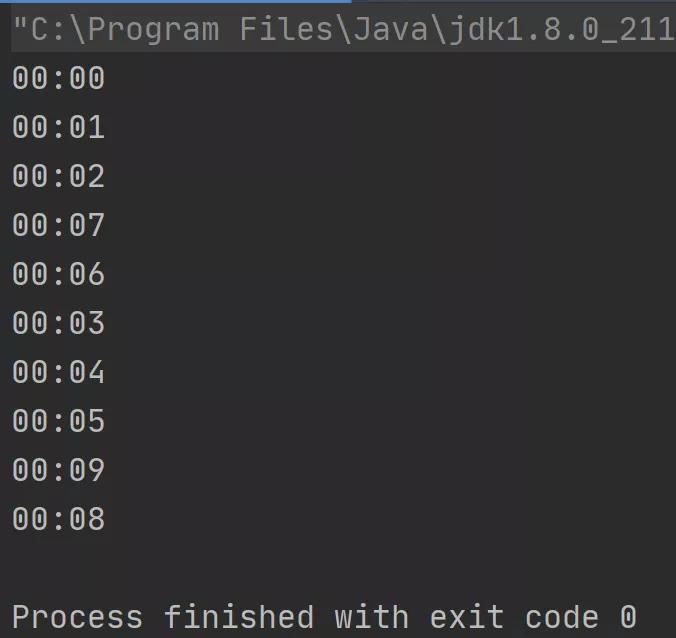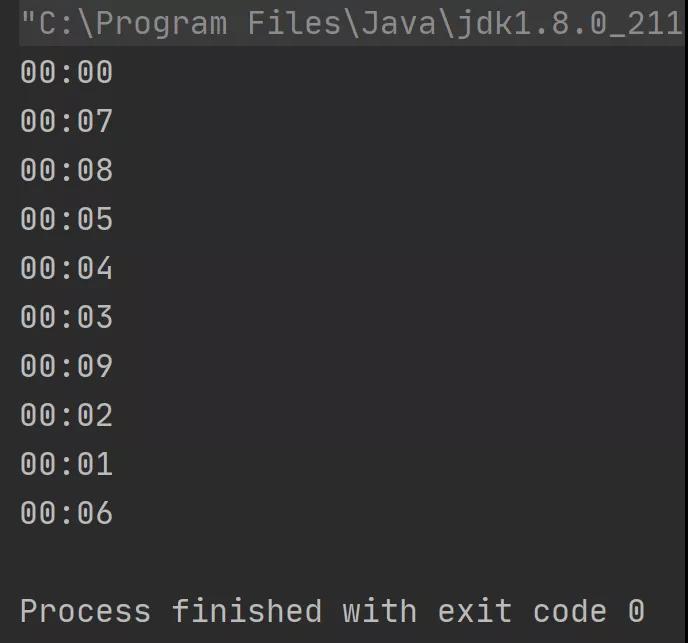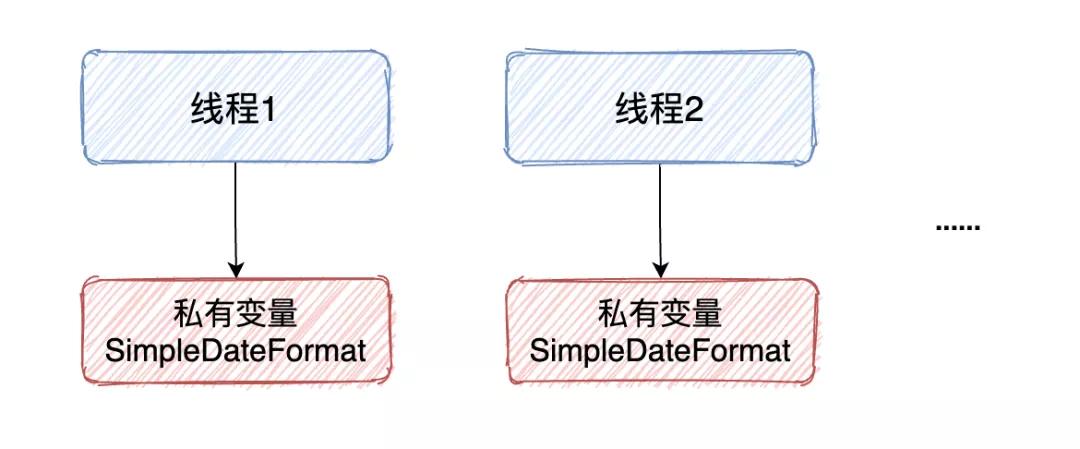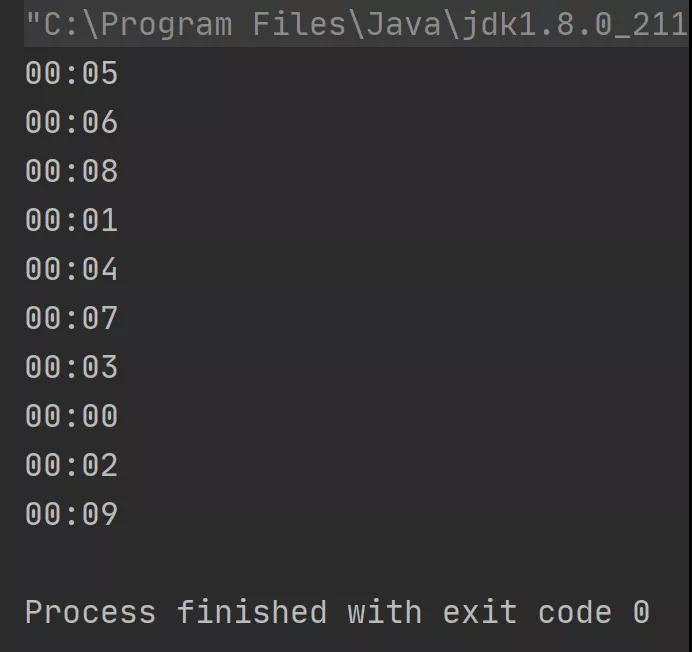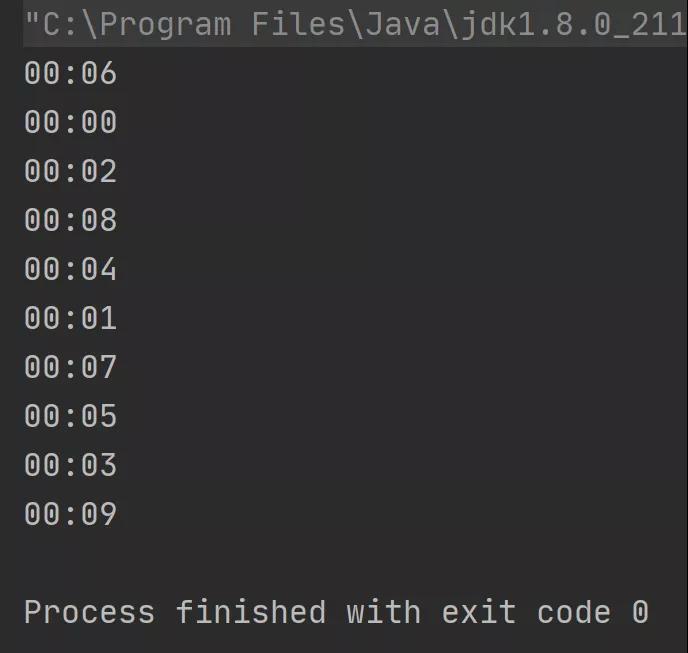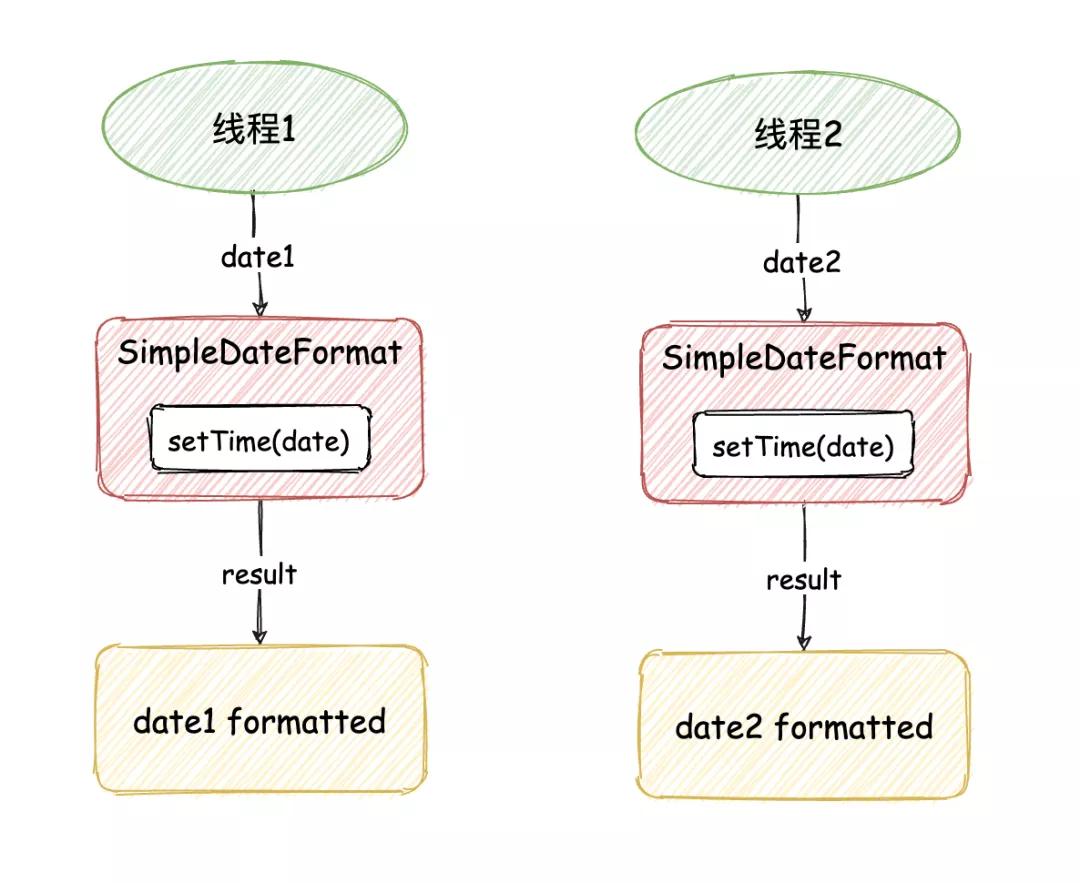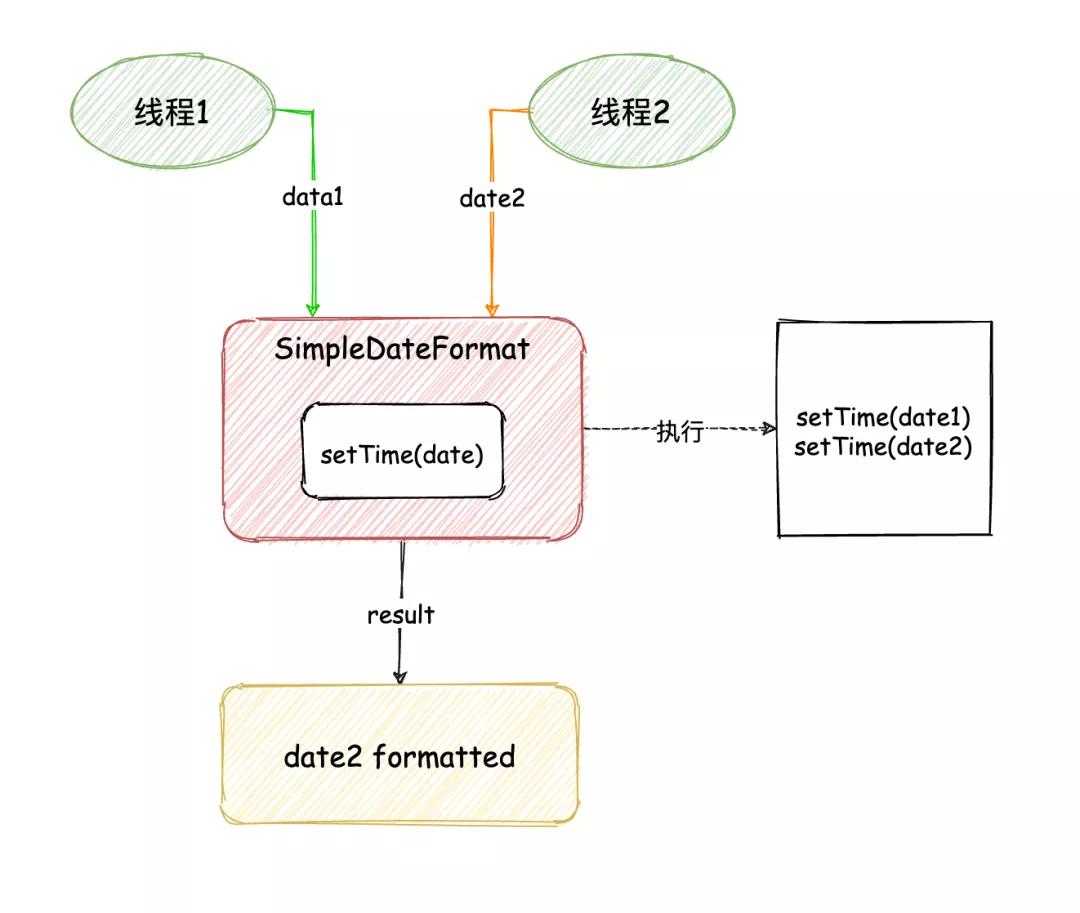SimpleDateFormat線程不安全的5種解決方案!
本文轉(zhuǎn)載自微信公眾號(hào)「Java中文社群」,作者磊哥。轉(zhuǎn)載本文請(qǐng)聯(lián)系Java中文社群公眾號(hào)。
1.什么是線程不安全?
線程不安全也叫非線程安全,是指多線程執(zhí)行中,程序的執(zhí)行結(jié)果和預(yù)期的結(jié)果不符的情況就叫著線程不安全。
線程不安全的代碼
SimpleDateFormat 就是一個(gè)典型的線程不安全事例,接下來(lái)我們動(dòng)手來(lái)實(shí)現(xiàn)一下。首先我們先創(chuàng)建 10 個(gè)線程來(lái)格式化時(shí)間,時(shí)間格式化每次傳遞的待格式化時(shí)間都是不同的,所以程序如果正確執(zhí)行將會(huì)打印 10 個(gè)不同的值,接下來(lái)我們來(lái)看具體的代碼實(shí)現(xiàn):
- import java.text.SimpleDateFormat;
- import java.util.Date;
- import java.util.concurrent.ExecutorService;
- import java.util.concurrent.Executors;
- public class SimpleDateFormatExample {
- // 創(chuàng)建 SimpleDateFormat 對(duì)象
- private static SimpleDateFormat simpleDateFormat = new SimpleDateFormat("mm:ss");
- public static void main(String[] args) {
- // 創(chuàng)建線程池
- ExecutorService threadPool = Executors.newFixedThreadPool(10);
- // 執(zhí)行 10 次時(shí)間格式化
- for (int i = 0; i < 10; i++) {
- int finalI = i;
- // 線程池執(zhí)行任務(wù)
- threadPool.execute(new Runnable() {
- @Override
- public void run() {
- // 創(chuàng)建時(shí)間對(duì)象
- Date date = new Date(finalI * 1000);
- // 執(zhí)行時(shí)間格式化并打印結(jié)果
- System.out.println(simpleDateFormat.format(date));
- }
- });
- }
- }
- }
我們預(yù)期的正確結(jié)果是這樣的(10 次打印的值都不同):
然而,以上程序的運(yùn)行結(jié)果卻是這樣的:
從上述結(jié)果可以看出,當(dāng)在多線程中使用 SimpleDateFormat 進(jìn)行時(shí)間格式化是線程不安全的。
2.解決方案
SimpleDateFormat 線程不安全的解決方案總共包含以下 5 種:
- 將 SimpleDateFormat 定義為局部變量;
- 使用 synchronized 加鎖執(zhí)行;
- 使用 Lock 加鎖執(zhí)行(和解決方案 2 類似);
- 使用 ThreadLocal;
- 使用 JDK 8 中提供的 DateTimeFormat。
接下來(lái)我們分別來(lái)看每種解決方案的具體實(shí)現(xiàn)。
① SimpleDateFormat改為局部變量
將 SimpleDateFormat 定義為局部變量時(shí),因?yàn)槊總€(gè)線程都是獨(dú)享 SimpleDateFormat 對(duì)象的,相當(dāng)于將多線程程序變成“單線程”程序了,所以不會(huì)有線程不安全的問(wèn)題,具體實(shí)現(xiàn)代碼如下:
- import java.text.SimpleDateFormat;
- import java.util.Date;
- import java.util.concurrent.ExecutorService;
- import java.util.concurrent.Executors;
- public class SimpleDateFormatExample {
- public static void main(String[] args) {
- // 創(chuàng)建線程池
- ExecutorService threadPool = Executors.newFixedThreadPool(10);
- // 執(zhí)行 10 次時(shí)間格式化
- for (int i = 0; i < 10; i++) {
- int finalI = i;
- // 線程池執(zhí)行任務(wù)
- threadPool.execute(new Runnable() {
- @Override
- public void run() {
- // 創(chuàng)建 SimpleDateFormat 對(duì)象
- SimpleDateFormat simpleDateFormat = new SimpleDateFormat("mm:ss");
- // 創(chuàng)建時(shí)間對(duì)象
- Date date = new Date(finalI * 1000);
- // 執(zhí)行時(shí)間格式化并打印結(jié)果
- System.out.println(simpleDateFormat.format(date));
- }
- });
- }
- // 任務(wù)執(zhí)行完之后關(guān)閉線程池
- threadPool.shutdown();
- }
- }
以上程序的執(zhí)行結(jié)果為:
當(dāng)打印的結(jié)果都不相同時(shí),表示程序的執(zhí)行是正確的,從上述結(jié)果可以看出,將 SimpleDateFormat 定義為局部變量之后,就可以成功的解決線程不安全問(wèn)題了。
② 使用synchronized加鎖
鎖是解決線程不安全問(wèn)題最常用的手段,接下來(lái)我們先用 synchronized 來(lái)加鎖進(jìn)行時(shí)間格式化,實(shí)現(xiàn)代碼如下:
- import java.text.SimpleDateFormat;
- import java.util.Date;
- import java.util.concurrent.ExecutorService;
- import java.util.concurrent.Executors;
- public class SimpleDateFormatExample2 {
- // 創(chuàng)建 SimpleDateFormat 對(duì)象
- private static SimpleDateFormat simpleDateFormat = new SimpleDateFormat("mm:ss");
- public static void main(String[] args) {
- // 創(chuàng)建線程池
- ExecutorService threadPool = Executors.newFixedThreadPool(10);
- // 執(zhí)行 10 次時(shí)間格式化
- for (int i = 0; i < 10; i++) {
- int finalI = i;
- // 線程池執(zhí)行任務(wù)
- threadPool.execute(new Runnable() {
- @Override
- public void run() {
- // 創(chuàng)建時(shí)間對(duì)象
- Date date = new Date(finalI * 1000);
- // 定義格式化的結(jié)果
- String result = null;
- synchronized (simpleDateFormat) {
- // 時(shí)間格式化
- result = simpleDateFormat.format(date);
- }
- // 打印結(jié)果
- System.out.println(result);
- }
- });
- }
- // 任務(wù)執(zhí)行完之后關(guān)閉線程池
- threadPool.shutdown();
- }
- }
以上程序的執(zhí)行結(jié)果為:
③ 使用Lock加鎖
在 Java 語(yǔ)言中,鎖的常用實(shí)現(xiàn)方式有兩種,除了 synchronized 之外,還可以使用手動(dòng)鎖 Lock,接下來(lái)我們使用 Lock 來(lái)對(duì)線程不安全的代碼進(jìn)行改造,實(shí)現(xiàn)代碼如下:
- import java.text.SimpleDateFormat;
- import java.util.Date;
- import java.util.concurrent.ExecutorService;
- import java.util.concurrent.Executors;
- import java.util.concurrent.locks.Lock;
- import java.util.concurrent.locks.ReentrantLock;
- /**
- * Lock 解決線程不安全問(wèn)題
- */
- public class SimpleDateFormatExample3 {
- // 創(chuàng)建 SimpleDateFormat 對(duì)象
- private static SimpleDateFormat simpleDateFormat = new SimpleDateFormat("mm:ss");
- public static void main(String[] args) {
- // 創(chuàng)建線程池
- ExecutorService threadPool = Executors.newFixedThreadPool(10);
- // 創(chuàng)建 Lock 鎖
- Lock lock = new ReentrantLock();
- // 執(zhí)行 10 次時(shí)間格式化
- for (int i = 0; i < 10; i++) {
- int finalI = i;
- // 線程池執(zhí)行任務(wù)
- threadPool.execute(new Runnable() {
- @Override
- public void run() {
- // 創(chuàng)建時(shí)間對(duì)象
- Date date = new Date(finalI * 1000);
- // 定義格式化的結(jié)果
- String result = null;
- // 加鎖
- lock.lock();
- try {
- // 時(shí)間格式化
- result = simpleDateFormat.format(date);
- } finally {
- // 釋放鎖
- lock.unlock();
- }
- // 打印結(jié)果
- System.out.println(result);
- }
- });
- }
- // 任務(wù)執(zhí)行完之后關(guān)閉線程池
- threadPool.shutdown();
- }
- }
以上程序的執(zhí)行結(jié)果為:
從上述代碼可以看出,手動(dòng)鎖的寫法相比于 synchronized 要繁瑣一些。
④ 使用ThreadLocal
加鎖方案雖然可以正確的解決線程不安全的問(wèn)題,但同時(shí)也引入了新的問(wèn)題,加鎖會(huì)讓程序進(jìn)入排隊(duì)執(zhí)行的流程,從而一定程度的降低了程序的執(zhí)行效率,如下圖所示:
那有沒(méi)有一種方案既能解決線程不安全的問(wèn)題,同時(shí)還可以避免排隊(duì)執(zhí)行呢?
答案是有的,可以考慮使用 ThreadLocal。ThreadLocal 翻譯為中文是線程本地變量的意思,字如其人 ThreadLocal 就是用來(lái)創(chuàng)建線程的私有(本地)變量的,每個(gè)線程擁有自己的私有對(duì)象,這樣就可以避免線程不安全的問(wèn)題了,實(shí)現(xiàn)如下:
知道了實(shí)現(xiàn)方案之后,接下來(lái)我們使用具體的代碼來(lái)演示一下 ThreadLocal 的使用,實(shí)現(xiàn)代碼如下:
- import java.text.SimpleDateFormat;
- import java.util.Date;
- import java.util.concurrent.ExecutorService;
- import java.util.concurrent.Executors;
- /**
- * ThreadLocal 解決線程不安全問(wèn)題
- */
- public class SimpleDateFormatExample4 {
- // 創(chuàng)建 ThreadLocal 對(duì)象,并設(shè)置默認(rèn)值(new SimpleDateFormat)
- private static ThreadLocal<SimpleDateFormat> threadLocal =
- ThreadLocal.withInitial(() -> new SimpleDateFormat("mm:ss"));
- public static void main(String[] args) {
- // 創(chuàng)建線程池
- ExecutorService threadPool = Executors.newFixedThreadPool(10);
- // 執(zhí)行 10 次時(shí)間格式化
- for (int i = 0; i < 10; i++) {
- int finalI = i;
- // 線程池執(zhí)行任務(wù)
- threadPool.execute(new Runnable() {
- @Override
- public void run() {
- // 創(chuàng)建時(shí)間對(duì)象
- Date date = new Date(finalI * 1000);
- // 格式化時(shí)間
- String result = threadLocal.get().format(date);
- // 打印結(jié)果
- System.out.println(result);
- }
- });
- }
- // 任務(wù)執(zhí)行完之后關(guān)閉線程池
- threadPool.shutdown();
- }
- }
以上程序的執(zhí)行結(jié)果為:
ThreadLocal和局部變量的區(qū)別
首先來(lái)說(shuō) ThreadLocal 不等于局部變量,這里的“局部變量”指的是像 2.1 示例代碼中的局部變量, ThreadLocal 和局部變量最大的區(qū)別在于:ThreadLocal 屬于線程的私有變量,如果使用的是線程池,那么 ThreadLocal 中的變量是可以重復(fù)使用的,而代碼級(jí)別的局部變量,每次執(zhí)行時(shí)都會(huì)創(chuàng)建新的局部變量,二者區(qū)別如下圖所示:
更多關(guān)于 ThreadLocal 的內(nèi)容,可以訪問(wèn)磊哥前面的文章《ThreadLocal不好用?那是你沒(méi)用對(duì)!》。
⑤ 使用DateTimeFormatter
以上 4 種解決方案都是因?yàn)?SimpleDateFormat 是線程不安全的,所以我們需要加鎖或者使用 ThreadLocal 來(lái)處理,然而,JDK 8 之后我們就有了新的選擇,如果使用的是 JDK 8+ 版本,就可以直接使用 JDK 8 中新增的、安全的時(shí)間格式化工具類 DateTimeFormatter 來(lái)格式化時(shí)間了,接下來(lái)我們來(lái)具體實(shí)現(xiàn)一下。
使用 DateTimeFormatter 必須要配合 JDK 8 中新增的時(shí)間對(duì)象 LocalDateTime 來(lái)使用,因此在操作之前,我們可以先將 Date 對(duì)象轉(zhuǎn)換成 LocalDateTime,然后再通過(guò) DateTimeFormatter 來(lái)格式化時(shí)間,具體實(shí)現(xiàn)代碼如下:
- import java.time.LocalDateTime;
- import java.time.ZoneId;
- import java.time.format.DateTimeFormatter;
- import java.util.Date;
- import java.util.concurrent.ExecutorService;
- import java.util.concurrent.Executors;
- /**
- * DateTimeFormatter 解決線程不安全問(wèn)題
- */
- public class SimpleDateFormatExample5 {
- // 創(chuàng)建 DateTimeFormatter 對(duì)象
- private static DateTimeFormatter dateTimeFormatter = DateTimeFormatter.ofPattern("mm:ss");
- public static void main(String[] args) {
- // 創(chuàng)建線程池
- ExecutorService threadPool = Executors.newFixedThreadPool(10);
- // 執(zhí)行 10 次時(shí)間格式化
- for (int i = 0; i < 10; i++) {
- int finalI = i;
- // 線程池執(zhí)行任務(wù)
- threadPool.execute(new Runnable() {
- @Override
- public void run() {
- // 創(chuàng)建時(shí)間對(duì)象
- Date date = new Date(finalI * 1000);
- // 將 Date 轉(zhuǎn)換成 JDK 8 中的時(shí)間類型 LocalDateTime
- LocalDateTime localDateTime =
- LocalDateTime.ofInstant(date.toInstant(), ZoneId.systemDefault());
- // 時(shí)間格式化
- String result = dateTimeFormatter.format(localDateTime);
- // 打印結(jié)果
- System.out.println(result);
- }
- });
- }
- // 任務(wù)執(zhí)行完之后關(guān)閉線程池
- threadPool.shutdown();
- }
- }
以上程序的執(zhí)行結(jié)果為:
3.線程不安全原因分析
要了解 SimpleDateFormat 為什么是線程不安全的?我們需要查看并分析 SimpleDateFormat 的源碼才行,那我們先從使用的方法 format 入手,源碼如下:
- private StringBuffer format(Date date, StringBuffer toAppendTo,
- FieldDelegate delegate) {
- // 注意此行代碼
- calendar.setTime(date);
- boolean useDateFormatSymbols = useDateFormatSymbols();
- for (int i = 0; i < compiledPattern.length; ) {
- int tag = compiledPattern[i] >>> 8;
- int count = compiledPattern[i++] & 0xff;
- if (count == 255) {
- count = compiledPattern[i++] << 16;
- count |= compiledPattern[i++];
- }
- switch (tag) {
- case TAG_QUOTE_ASCII_CHAR:
- toAppendTo.append((char)count);
- break;
- case TAG_QUOTE_CHARS:
- toAppendTo.append(compiledPattern, i, count);
- i += count;
- break;
- default:
- subFormat(tag, count, delegate, toAppendTo, useDateFormatSymbols);
- break;
- }
- }
- return toAppendTo;
- }
也許是好運(yùn)使然,沒(méi)想到剛開(kāi)始分析第一個(gè)方法就找到了線程不安全的問(wèn)題所在。
從上述源碼可以看出,在執(zhí)行 SimpleDateFormat.format 方法時(shí),會(huì)使用 calendar.setTime 方法將輸入的時(shí)間進(jìn)行轉(zhuǎn)換,那么我們想象一下這樣的場(chǎng)景:
- 線程 1 執(zhí)行了 calendar.setTime(date) 方法,將用戶輸入的時(shí)間轉(zhuǎn)換成了后面格式化時(shí)所需要的時(shí)間;
- 線程 1 暫停執(zhí)行,線程 2 得到 CPU 時(shí)間片開(kāi)始執(zhí)行;
- 線程 2 執(zhí)行了 calendar.setTime(date) 方法,對(duì)時(shí)間進(jìn)行了修改;
- 線程 2 暫停執(zhí)行,線程 1 得出 CPU 時(shí)間片繼續(xù)執(zhí)行,因?yàn)榫€程 1 和線程 2 使用的是同一對(duì)象,而時(shí)間已經(jīng)被線程 2 修改了,所以此時(shí)當(dāng)線程 1 繼續(xù)執(zhí)行的時(shí)候就會(huì)出現(xiàn)線程安全的問(wèn)題了。
正常的情況下,程序的執(zhí)行是這樣的:
非線程安全的執(zhí)行流程是這樣的:
在多線程執(zhí)行的情況下,線程 1 的 date1 和線程 2 的 date2,因?yàn)閳?zhí)行順序的問(wèn)題,最終都被格式化成 date2 formatted,而非線程 1 date1 formatted 和線程 2 date2 formatted,這樣就會(huì)導(dǎo)致線程不安全的問(wèn)題。
4.各方案優(yōu)缺點(diǎn)總結(jié)
如果使用的是 JDK 8+ 版本,可以直接使用線程安全的 DateTimeFormatter 來(lái)進(jìn)行時(shí)間格式化,如果使用的 JDK 8 以下版本或者改造老的 SimpleDateFormat 代碼,可以考慮使用 synchronized 或 ThreadLocal 來(lái)解決線程不安全的問(wèn)題。因?yàn)閷?shí)現(xiàn)方案 1 局部變量的解決方案,每次執(zhí)行的時(shí)候都會(huì)創(chuàng)建新的對(duì)象,因此不推薦使用。synchronized 的實(shí)現(xiàn)比較簡(jiǎn)單,而使用 ThreadLocal 可以避免加鎖排隊(duì)執(zhí)行的問(wèn)題。














